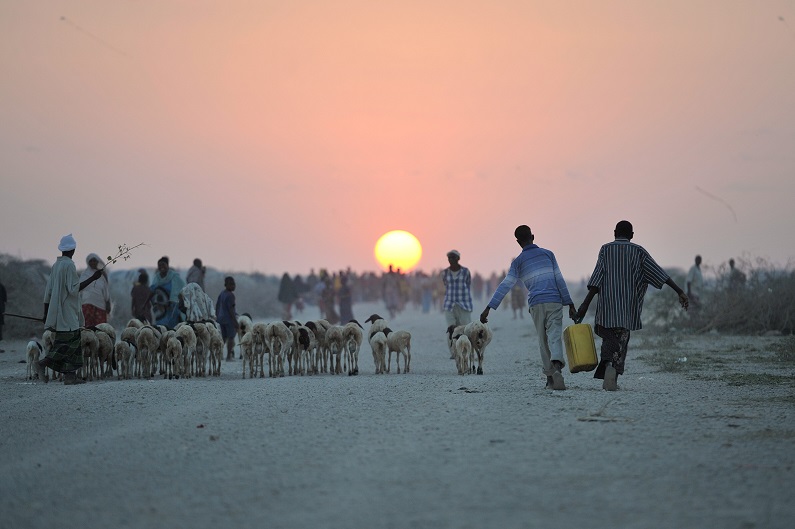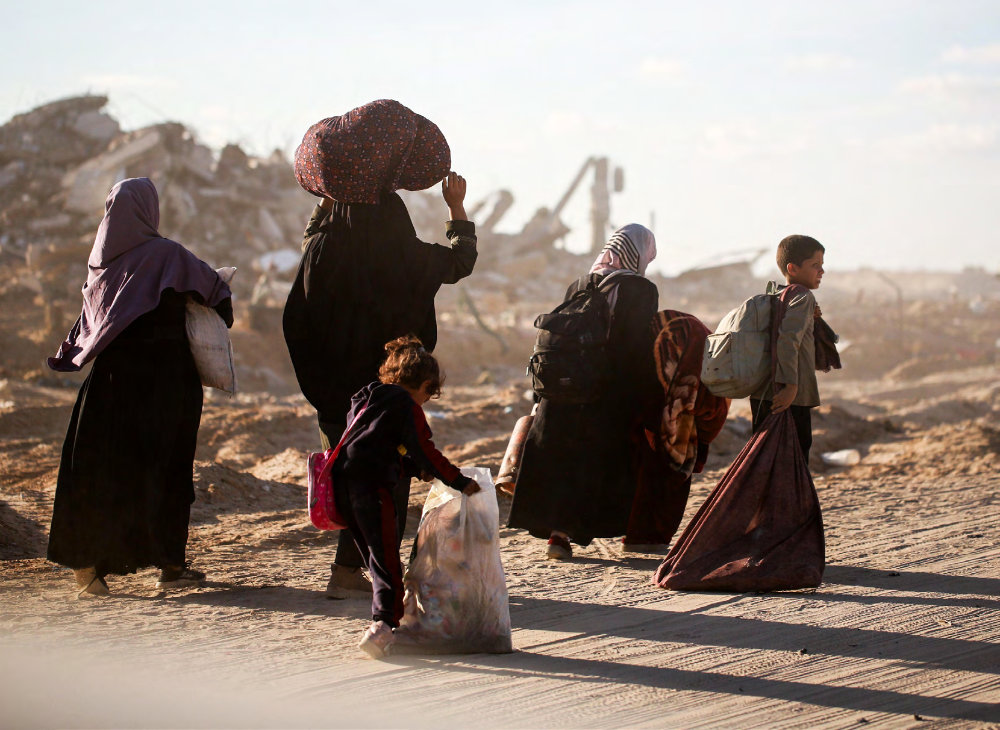If the 2021 IPCC report is a code red for humanity, then humanitarian organizations are the first responders. Humanitarian organizations do not just deal with climate-related disasters, they also often work in regions where the combined impacts of climate change and conflict increase the challenges of both emergency relief and longer-term development.
In this post, Kheira Tarif, Research Assistant in the Climate Change and Risk Programme at the Stockholm International Peace Research Institute (SIPRI) argues that new tools are needed in the humanitarian toolkit to make conflict analyses more climate-sensitive and anticipate climate-related security risks.
A better understanding of the connections between climate impacts and conflict requires more than data. At the Stockholm International Peace Research Institute (SIPRI), we have identified four well-evidenced ‘pathways of climate insecurity’. These ‘pathways’ are areas in which the physical and human impacts of climate change can interact with local political or socio-economic factors, increasing the risk of conflict.
Structuring climate security-risk analysis around the four pathways, in combination with available climatic data, can help to bring the most important links into focus. It can also suggest the most effective areas for humanitarian intervention in order to avert risks to peace.
Livelihood insecurity
The first pathway is via livelihood insecurity. The physical impacts of climate change render a family or community’s main source of livelihood less viable. This most commonly happens when people practice subsistence farming, herding, fishing or other livelihoods that rely heavily on weather conditions and renewable natural resources.
A range of problems arise that can increase risks to peace, particularly in the absence of livelihood alternatives and trusted, inclusive institutions. It can increase local competition for limited resources. It can lead to a rise in criminality. It can lead to migration. Increased poverty, food insecurity and dissatisfaction with government services can be exploited by armed groups and elites.
Examples of the livelihoods insecurity pathway at work can be found in Burkina Faso, in West Africa’s Sahel region. Existing climate data shows that northern dry zones have extended southwards in the past hundred years, and the highest monthly temperatures are becoming the norm. The Notre Dame Global Adaptation Initiative (ND GAIN) Index measures both climate vulnerability and readiness to respond to the effects of climate change, and ranks Burkina Faso among the countries most exposed to the physical effects of climate change.
In the conflict-affected north of the country, droughts have led some herders to rely less on seasonal livestock migration and more on crop cultivation. But this shift has intensified land and water use, and increased competition with other farmers. In neighbouring Niger, pastoralists have sometimes responded to resource stress by moving their livestock on farmed lands for grazing, creating tensions that can lead to communal violence. These examples show how adaptation meant to help cope with climate change can also exacerbate security risks.
Humanitarian actors operating in the region should be alert to the potential security risks associated with this pathway, and take steps to mitigate them by including affected groups, like pastoralists, in planning and developing responses.
Migration
Migration is a relatively common response to climate hazards. It can range from temporary evacuation to escape flooding or wildfire to permanently moving home to a new area or, less often, to a new country.
Migrant populations are often vulnerable to violence and exploitation. They may feel dislocated from familiar institutions and social groups. Their presence in a new community can lead to tensions and resentment, emotions sometimes further fueled by political leaders. And migrations can alter the demographics of an area, upsetting sensitive relations and power-sharing arrangements between, for example, local tribes or clans.
Recent developments in Somalia provide a good illustration of the migration pathway at work. Somalia is one of the Horn of Africa’s most climate-exposed countries. Available climate data shows that regional temperatures have increased by at least 1°C this century. Precipitation levels are low and erratic; droughts occur frequently and are often followed by severe floods. ND-GAIN consistently ranks Somalia in the top ten most climate-vulnerable countries.
Around 80% of Somalis are involved in agriculture. In the first half of 2019, 53,000 Somalis were displaced by drought, adding to around 2.6 million already displaced by conflict, climatic factors and more. The city of Baidoa alone hosted around 323,000 internally displaced people (IDPs).
According to an officer with the United Nations Assistance Mission in Somalia (UNSOM), the influx of IDPs to Baidoa altered the demographic and clan/ethnic composition of the city, undermining a fragile power-sharing agreement and setting back UN peacebuilding efforts. In other urban centres, like Mogadishu, the outcomes of mass displacement on local balances of power has added another layer to long-standing fragility, resulting once again in violent clashes between clans.
The migration pathway underlines the importance of analyzing climate-related conflict risks not only in climate change hotspots but also in neighbouring areas that affected groups may head for.
Tactics of armed groups
Humanitarian crises are often exacerbated or even caused by the activities of armed groups. However, there are also instances where armed groups have altered their tactics and turned climate impacts into opportunities to gain influence and recruits, as well as profit.
One interesting twist on the armed groups pathway was seen in pre-2021 Afghanistan. Available data shows that national temperatures rose by around 1.5°C in the past century, with significant increases in the severity of droughts in southern and western regions. Water stress, due to the combined effects of bad weather conditions and conflict, has had a devastating effect on agriculture, which supports the income of around 60% of the population. As of 2020, one-third of the population were living with acute and severe food insecurity.
Hard-pressed Afghan farmers in drought-affected regions have sometimes opted to cultivate opium poppies, which are more drought-resistant and profitable than staples like wheat. This shift in livelihood strategies has sometimes been a boon for vulnerable groups, allowing some Afghan women to build financial independence and social status. But there is evidence that armed groups exploited opium cultivation to increase support and revenue; they offered protection to poppy farmers, traders and smugglers in return for a tax.
In contexts where armed groups are locally active, humanitarian organizations should use conflict risk analyses to consider how climate impacts, and local responses to them, could create opportunities for armed groups.
Exploitation by elites
Like armed groups, elites – whether political or commercial – can also take advantage of climate-related crises in ways that increase security risks. Once again, this can take many forms, from dispossessing or exploiting affected populations to stirring up fears and grievances for political advantage.
Ghana is relatively safe and fertile, compared to some of its West African neighbours, and ranks as less vulnerable to the impacts of climate change. This has drawn an increasing number of migrant herders—mainly from the Fulani ethnic group—to predominantly agricultural areas of Ghana. In some cases, the resulting added pressure on resources has led to conflicts between farmers and herders.
While these conflicts are localized and small-scale, they have sometimes been exploited and accelerated by local or national elites to advance their control over resources or further other strategic aims.
There is a higher risk that such resource conflicts escalate when local disputes overlap with political narratives around immigrants or during election periods. In Ghana, policies to expel the Fulani are couched in divisive narratives about ethnicity and nationality and the rights of indigenous Ghanaians over the Fulani migrant ‘strangers’. Observers have suggested that this is a politically expedient alternative to regulating or sedentarizing migrant herders.
Climate change is not happening in a political vacuum; policy decisions can accentuate the marginalization and vulnerability of livestock herders in West African States with secondary effects on regional peace and security. Humanitarian organizations should seek to understand the broader political context of climate change and the ways in which its effects on local lives and local disputes can overlap with bigger trends.
Building an environment of peace
Even if all of the Paris Agreement targets are met, we have entered an era when climate change, and how people will respond to it, will have a strong influence on many aspects of human life. Security, environment and human welfare are intertwined in ever more intimate and unpredictable ways—a phenomenon that is currently being explored by SIPRI’s Environment of Peace initiative.
As humanitarian organizations work in ever more complex, precarious situations, with higher stakes, these pathways of´climate insecurity can help them navigate the new climate challenges.
See also
- Ariana Lopes Morey, Menty Kebede, Matt Pollard, Beyond access: three considerations for food security and famine prevention during armed conflict, April 24, 2022
- Catherine-Lune Grayson, A plea for COP26: don’t forget people affected by conflict, October 27, 2021
- Tessa Kelly, Catherine-Luhe Grayson & Amir Khouzam, Standing together: the Climate and Environment Charter for Humanitarian Organizations, 21 May 2021
- Cécile Aptel, The future is now: time to scale up climate mitigation and adaptation measures, February 6, 2020
- Catherine-Lune Grayson, When rain turns to dust: climate change, conflict and humanitarian action, December 5, 2019






Articulo muy interesante, me gustaría ponerme en contacto con la autora, (Asistente de investigación, Instituto Internacional de Investigación para la Paz de Estocolmo), para intercambiar ideas, en vista de que estoy desarrollando una investigación como parte de mi tesis Doctoral sobre; “Construcción de una Cultura de Paz duradera a través de la energías renovables”, en particular la energía fotovoltaica (energía solar). para reemplazar la actual matriz energética, basada en energías fósiles. Así mismo en el año 2021 envié unos correos al Dr. Johan Galtung, para comentarle sobre el titulo de la investigación y recibir sus orientaciones, que se que gustoso me las hubiera brindado; en la respuesta a los correos se me hizo conocer que el Doctor se ha retirado de la vida publica a sus noventa años, dedicados a la paz en el mundo. Atento a vuestra respuesta desde ya las gracias.
Hola Eduardo y gracias por leer! Puedes seguir a la autora en Twitter en @tarif_kh y contactarla allí. La mejor de las suertes con tu investigación, Lizzie.